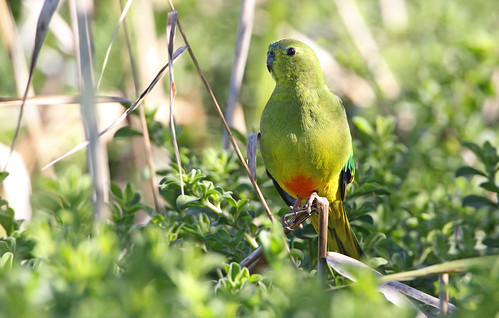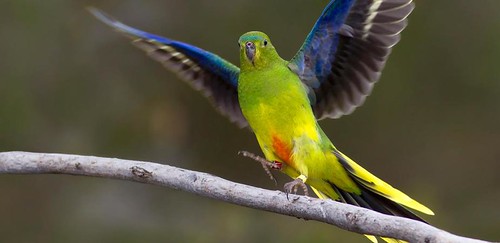 Somehow the Orange-bellied Parrot is always getting into trouble. Image by Fatih SamIf you had to ask an average Australian the name of a threatened bird in this country, many would nominate the Orange-bellied Parrot. Critically endangered, and with fewer than 50 left in the wild, it is justifiably one of Australia’s most well-known endangered species.
Somehow the Orange-bellied Parrot is always getting into trouble. Image by Fatih SamIf you had to ask an average Australian the name of a threatened bird in this country, many would nominate the Orange-bellied Parrot. Critically endangered, and with fewer than 50 left in the wild, it is justifiably one of Australia’s most well-known endangered species.
Poor little creature. Every year the last birds remaining in the wild leave their breeding grounds at Melaleuca in the remote south-west wilderness of Tasmania to fly to the saltmarshes along the coastline of Victoria and South Australia. And each year hundreds of volunteers go out to count the birds and see how they are faring.
Yet somehow the poor Orange-bellied Parrot is always getting into trouble.
The first incident was in 1996 when Jeff Kennett wanted to move the Coode Island Chemical storage facility south-west to Point Cook and discovered that the area was favoured habitat for the parrot. He didn’t want any “trumped up corella” (a distantly-related species of cockatoo) to stop his development – a name that conservationists subsequently adopted as their newsletter on the species. It was even listed in a recent book as the only bird name coined by a politician.
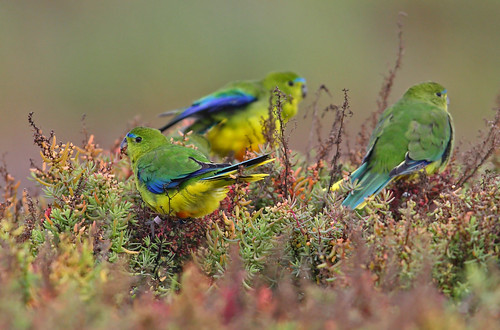 Orange-bellied Parrots in their winter saltmarsh habitat. Image by Chris Tzaros
Orange-bellied Parrots in their winter saltmarsh habitat. Image by Chris Tzaros
Ten years later Environment Minister Ian Campbell decided that the bird could be used as an excuse not to allow the construction of a wind farm in a friend’s electorate in Gippsland. The chances of any birds hitting the turbines were vanishingly small, and he was forced to reverse the decision, but not before the parrot’s reputation as a hindrance to development had been strengthened.
More recently, in 2012, the bird was blamed for holding up a marina development in Westernport. The site also happened to be beside a globally important wetland but the parrot copped the blame, even though it had not been seen there for 25 years.
The trouble is that no-one has yet been able to put their finger on why the parrot is so rare. This is despite it being the first bird in Australia to have its own recovery team, set up in 1981.
Not that there is any shortage of theories.
For a long time the most popular theory was a shortage of habitat in winter. Many saltmarshes have been reclaimed along the southern coast of Australia. Those remaining are full of nasty introduced predators like foxes and cats and invaded by weeds. Much work has been done to identify and protect the remaining coastal habitat. However few of these sites still get parrots, even though the birds have learnt to eat the weeds.
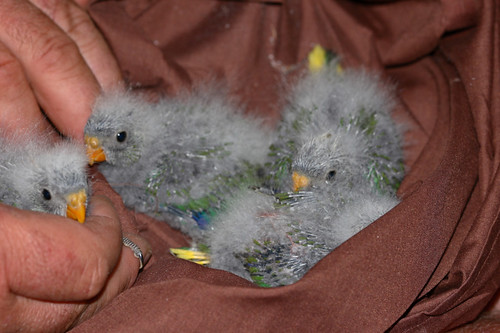 Over 200 Orange-bellied Parrots have been bred in captivity. Image by Chris TzarosThe birds are also under pressure at breeding sites in Tasmania. The birds nest in tree hollows that are also favoured by species introduced to Tasmania - such as the European Starling - which steal the nest sites.
Over 200 Orange-bellied Parrots have been bred in captivity. Image by Chris TzarosThe birds are also under pressure at breeding sites in Tasmania. The birds nest in tree hollows that are also favoured by species introduced to Tasmania - such as the European Starling - which steal the nest sites.
Fortunately few starlings visit Melaleuca. And, for most of its history, there have been very few people either. One of those few, however, may inadvertently have saved the parrot.
Deny King lived at Melaleuca from 1946 until his death in 1991.
A bushman’s bushman, he actively managed the environment by lighting small fires to create a mosaic of habitats of different ages, just as Aboriginal people are thought to have done for thousands of years.
Fires release nutrients and parrots love feeding on sedge and grass seed in the first years after they are burnt.
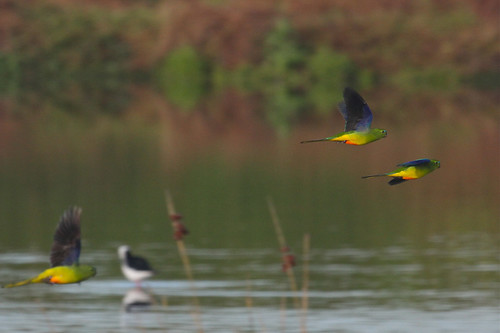 Every spring Orange-bellied Parrots fly from the mainland to the south coast of Tasmania, and return the following autumn. Image by Bruce RichardsonHowever keeping fires small is an art and few managers of the south-west wilderness had the skills to keep Deny’s legacy going, or else could not get permission from their park managers who feared fires getting out of control.
Every spring Orange-bellied Parrots fly from the mainland to the south coast of Tasmania, and return the following autumn. Image by Bruce RichardsonHowever keeping fires small is an art and few managers of the south-west wilderness had the skills to keep Deny’s legacy going, or else could not get permission from their park managers who feared fires getting out of control.
Perhaps a shortage of parrots is due to a shortage of fire.
This is certainly consistent with recent trends: breeding productivity increases after the parrots get all the food they can eat.
For a long time the population was estimated to be about 200. In 2009, however, it was noticed that numbers had fallen fast. Even worse was that very few of the remaining females even attempted to breed. Extinction appeared imminent.
To his credit, Environment Minister Peter Garrett acted fast. On advice from the Recovery Team he allowed enough parrots to be taken from the wild to secure an insurance population in captivity.
While a captive population had been established back in 1983, genetic work showed that there were too few to encompass all of the parrot’s genetic diversity. So, in 2011, 21 young birds were taken from nests and transferred into the captive population.
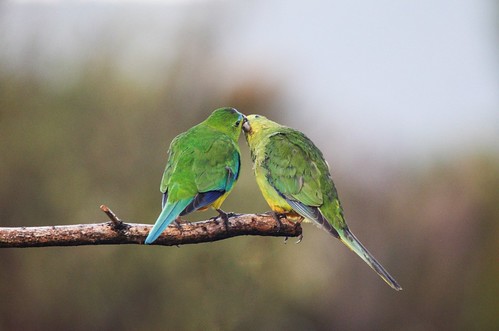 A male parrot feeding his mate. Image by: Tun Pin OngThey have done well. Currently there are over 200 birds in captivity at seven locations,.
A male parrot feeding his mate. Image by: Tun Pin OngThey have done well. Currently there are over 200 birds in captivity at seven locations,.
But, while they may be secure in captivity, what of the birds in the wild?
So far they seem to be hanging on. In the spring of 2012, 20 adults returned from migration, producing 22 chicks over the ensuing months. Burning has also been resumed and the birds are feeding on burnt country as well. All females attempted to breed.
This year 19 birds returned and the decision was made to boost the wild population with 23 birds reared in captivity - enough to augment the population, not enough to swamp wild behaviours. Earlier tests have shown, remarkably, that newly released birds can migrate to Victoria and back.
As of yesterday at least 14 pairs of Orange-bellied Parrots are breeding at Melaleuca this year. Also the first chicks of the year hatched at Taroona and Healesville.
Just possibly, the wild population at Melaleuca can be recovered with the help of their cousins in captivity. In the meantime the species remains a beacon of hope for those determined to retain all our biological heritage for our children.
